Exposure to Noise from Agricultural Machinery: Risk Assessment of Agricultural Workers in Italy
Abstract
1. Introduction
- (a)
- Exposure limit values: LEX, 8 h = 87 dB(A); Lpeak = 140 dB(C);
- (b)
- Upper action values: LEX, 8 h = 85 dB(A); Lpeak = 137 dB(C);
- (c)
- Lower action values: LEX, 8 h = 80 dB(A); Lpeak = 135 dB(C).
- The weekly noise exposure level does not exceed the exposure limit value of 87 dB(A); however, this condition must be confirmed by a suitable check.
- Adequate measures are taken to minimize the risks associated with these activities.
- (a)
- Peak sound pressure values (Lpeak);
- (b)
- Time-weighted equivalent noise exposure levels (LAeq.T);
- (c)
- Maximum (LAS max) and minimum (LAS min) values weighted according to the Slow time constant (S).
2. Materials and Methods
2.1. Sampling Techniques and Tools
- (a)
- Acoustically competent technicians enrolled in special regional and ministerial (ENTECA) lists, with proven experience;
- (b)
- A Larson & Davis 824 Class 1 integrating sound level meter conforming to CEI EN 61672-1 and to IEC no. 651/1979 class 1, IEC no. 804/1985 class 1 and ANSI S.1.4.1983 class 1 and provided with regular calibration certificates (Figure 2);
- (c)
- Sampling methodologies and subsequent data processing, provided in the UNI EN ISO 9612:2011 technical standards [11].
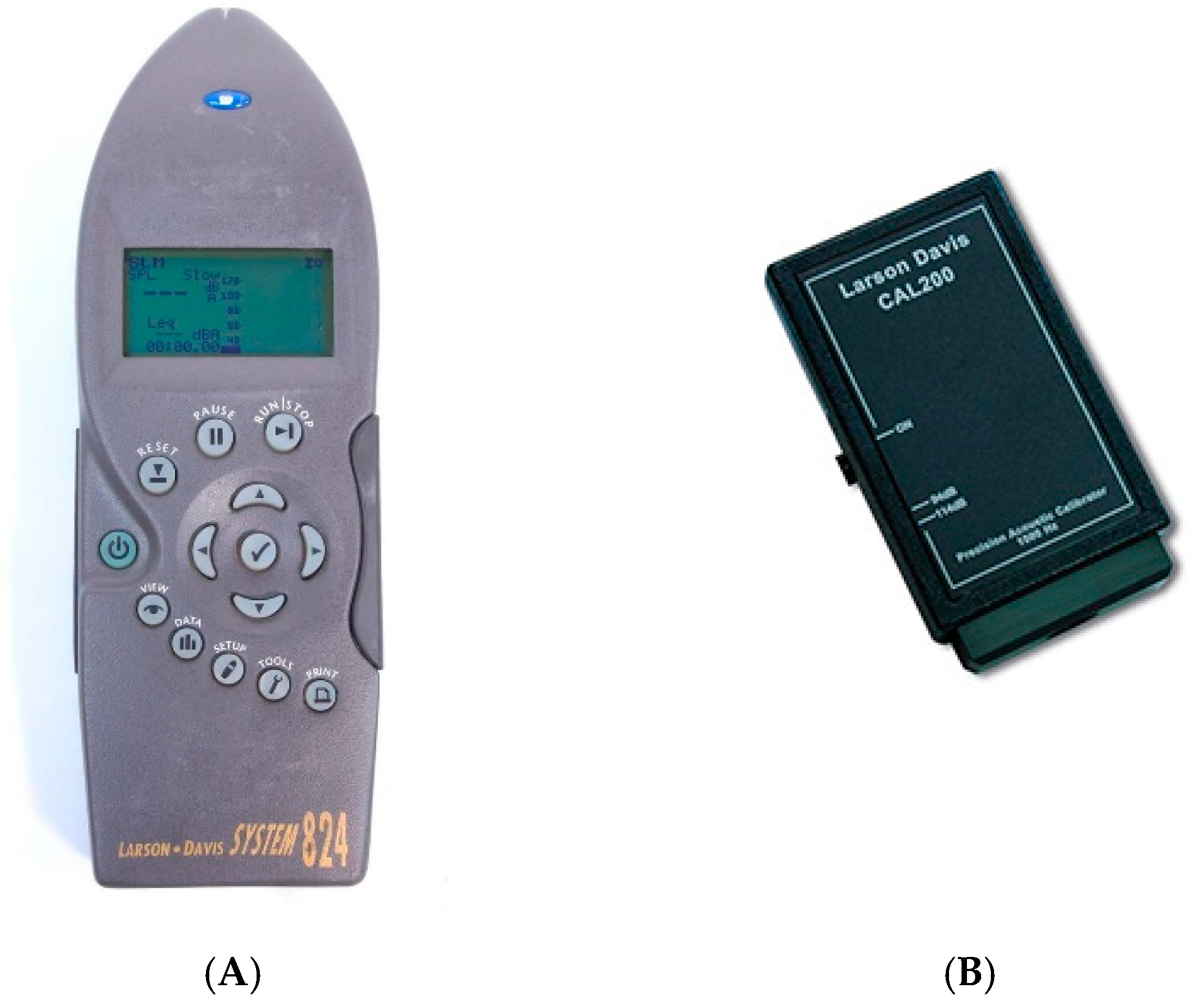
2.2. Variables Analyzed
- The A-weighted curve equivalent sound pressure level of workers’ noise exposure, normalized to an eight-hour working day (LEX,8h).
- The C-weighted curve peak sound pressure level (Lp, Cpeak or ppeak).
- -
- LeqA,Te is the A-weighted equivalent continuous sound pressure level for the time interval Te;
- -
- Te is the effective duration, in hours, of the working day;
- -
- T0 is the reference duration, T0 = 8 h.
- -
- pA is the A-weighted sound pressure curve expressed in pascals [Pa];
- -
- T is the time interval starting at t1 and ending at t2;
- -
- P0 is the reference sound pressure of 20 μPa.
- -
- ppeak is the C-curve-weighted peak sound pressure.
- -
- P0 is the reference sound pressure of 20 μPa.
2.3. Data Analysis
3. Results and Discussion
3.1. Noise Levels by Tractor Configuration
- -
- Lpeak = peak sound pressure (Ppeak): the maximum value of the instantaneous sound pressure weighted in the frequency “C”;
- -
- LAeq.T: the A-weighted value of the equivalent level (LAeq);
- -
- LAS: the maximum value of the maximum sound pressure level;
- -
- LAS: the minimum value of the minimum sound pressure level.
3.2. Tractors with Cabin and Without Cabin
3.3. Noise Level by Traction Type
3.4. Noise Levels by Operating Machine Type
4. Conclusions
Author Contributions
Funding
Institutional Review Board Statement
Data Availability Statement
Acknowledgments
Conflicts of Interest
References
- Bulat, P.; Somaruga, C.; Colosio, C. Occupational Health and Safety in Agriculture: Situation and Priorities at the Beginning of the Third Millennium. Med. Lav. 2006, 97, 420–429. [Google Scholar] [PubMed]
- Jakob, M.C.; Santa, D.; Holte, K.A.; Sikkeland, I.J.; Hilt, B.; Lundqvist, P. Occupational Health and Safety in Agriculture—A Brief Report on Organization, Legislation and Support in Selected European Countries. Ann. Agric. Environ. Med. 2021, 28, 452–457. [Google Scholar] [CrossRef] [PubMed]
- Bianchini, L.; Picchio, R.; Colantoni, A.; Scotolati, M.; Di Stefano, V.; Cecchini, M. Tensile Strength of Ropes and Friction Hitch Used in Tree Climbing Work. Forests 2021, 12, 1457. [Google Scholar] [CrossRef]
- Di Stefano, V.; Colantoni, A.; Di Domenico, G.; Cecchini, M.; Monarca, D. Lights and Shadows of Agricultural Workplace Safety Legislation in the Main EU Member States. In International Conference on Safety, Health and Welfare in Agriculture and Agro-Food Systems; Springer Nature: Cham, Switzerland, 2024; pp. 85–97. [Google Scholar]
- Hwang, S.J.; Nam, J.S. Effects of Noise and Vibration Changes from Agricultural Machinery on Brain Stress Using EEG Measurement. AgriEngineering 2024, 6, 4248–4266. [Google Scholar] [CrossRef]
- INAIL Open Data; INAIL: Rome, Italy, 2024; Available online: https://dati.inail.it/portale/it.html (accessed on 15 January 2025).
- Barač, Ž.; Plaščak, I.; Jurišić, M.; Tadić, V.; Zimmer, D.; Duvnjak, V. Noise in the Cabin of Agricultural Tractors. Teh. Vjesn. 2018, 25, 1611–1615. [Google Scholar] [CrossRef]
- Pessina, D.; Guerretti, M. Effectiveness of Hearing Protection Devices in the Hazard Reduction of Noise from Used Tractors. J. Agric. Eng. Res. 2000, 75, 73–80. [Google Scholar] [CrossRef]
- Han, H.W.; Im, W.H.; Choi, H.J.; Cho, S.J.; Lee, S.D.; Park, Y.J. Effect of Sound Insulation on Noise Reduction in an Agricultural Tractor Cab. Sci. Rep. 2022, 12, 22038. [Google Scholar] [CrossRef]
- Prendergast, G.; Guest, H.; Munro, K.J.; Kluk, K.; Léger, A.; Hall, D.A.; Heinz, M.G.; Plack, C.J. Effects of Noise Exposure on Young Adults with Normal Audiograms I: Electrophysiology. Hear. Res. 2017, 344, 68–81. [Google Scholar] [CrossRef]
- UNI EN ISO 9612:2011; Acoustics—Determination of Occupational Noise Exposure—Engineering Method. Ente Nazionale Italiano di Unificazione (UNI): Milan, Italy, 2011. Available online: https://store.uni.com/en/uni-en-iso-9612-2011 (accessed on 10 January 2025).
- Barač, Ž.; Radočaj, D.; Plaščak, I.; Jurišić, M.; Marković, M. Prediction of Noise Levels According to Some Exploitation Parameters of an Agricultural Tractor: A Machine Learning Approach. AgriEngineering 2024, 6, 995–1007. [Google Scholar] [CrossRef]
- Chavan, A.; Somasundaram, K.; Gunasekaran, P.; Chaudhari, V.V.; Sati, N. Investigating the Factors Affecting Cabin Comfort for Agricultural Machinery. In Symposium on International Automotive Technology; SAE Technical Papers; SAE: Vancouver, BC, Canada, 2024. [Google Scholar]
- Bianchini, L.; Alemanno, R.; Di Stefano, V.; Cecchini, M.; Colantoni, A. Soil Compaction in Harvesting Operations of Phalaris arundinacea L. Land 2022, 11, 1031. [Google Scholar] [CrossRef]
- Fornaciari, L.; Del Duca, L.; Pochi, D.; Grilli, R.; Biocca, M.; Bassotti, B.; Moschetto, A.; Benigni, S.; Fanigliulo, R. Investigation on the Applicability of an Active Noise Control System in the Tractor Cabin under Controlled Workload Condition. In International Conference on Safety, Health and Welfare in Agriculture and Agro-Food Systems; Springer Nature: Cham, Switzerland, 2024; pp. 38–48. [Google Scholar]
- Aiello, G.; Catania, P.; Vallone, M.; Venticinque, M. Worker Safety in Agriculture 4.0: A New Approach for Mapping Operator’s Vibration Risk through Machine Learning Activity Recognition. Comput. Electron. Agric. 2022, 193, 106637. [Google Scholar] [CrossRef]
- Fenske, R.A. New Technologies and Worker Safety in Western Agriculture. J. Agromed. 2009, 14, 417–420. [Google Scholar] [CrossRef] [PubMed]
- Mileusnić, Z.I.; Saljnikov, E.; Radojević, R.L.; Petrović, D.V. Soil Compaction Due to Agricultural Machinery Impact. J. Terramech. 2022, 100, 51–60. [Google Scholar] [CrossRef]
- Shahgholi, G.; Abuali, M. Measuring Soil Compaction and Soil Behavior under the Tractor Tire Using Strain Transducer. J. Terramech. 2015, 59, 19–25. [Google Scholar] [CrossRef]
- Cecchini, M.; Piccioni, F.; Ferri, S.; Coltrinari, G.; Bianchini, L.; Colantoni, A. Preliminary Investigation on Systems for the Preventive Diagnosis of Faults on Agricultural Operating Machines. Sensors 2021, 21, 1547. [Google Scholar] [CrossRef]
- Kukharets, S.; Zabrodskyi, A.; Sheludchenko, B.; Jasinskas, A.; Domeika, R.; Šarauskis, E. Assessment of Changes in Soil Contact Stress Depending on Tractor Tire Parameters. Sci. Rep. 2025, 15, 172. [Google Scholar] [CrossRef]
- Vallone, M.; Bono, F.; Quendler, E.; Febo, P.; Catania, P. Risk Exposure to Vibration and Noise in the Use of Agricultural Track-Laying Tractors. Ann. Agric. Environ. Med. 2016, 23, 591–597. [Google Scholar] [CrossRef]
- ten Damme, L.; Calleja-Huerta, A.; Juhl Munkholm, L.; Schjønning, P.; Keller, T.; Lamandé, M. Traction Modifies the Contact Area and the Vertical and Horizontal Stress Distributions beneath the Tyre. Soil Tillage Res. 2024, 244, 106214. [Google Scholar] [CrossRef]
- Lanças, K.P.; Marques Filho, A.C.; Santana, L.S.; Ferraz, G.A.E.S.; Faria, R.O.; Martins, M.B. Agricultural Tractor Test: A Bibliometric Review. AgriEngineering 2024, 6, 2229–2248. [Google Scholar] [CrossRef]
- Lie, A.; Skogstad, M.; Johannessen, H.A.; Tynes, T.; Mehlum, I.S.; Nordby, K.C.; Engdahl, B.; Tambs, K. Occupational Noise Exposure and Hearing: A Systematic Review. Int. Arch. Occup. Environ. Health 2016, 89, 351–372. [Google Scholar] [CrossRef]
- Suvorov, G.; Denisov, E.; Antipin, V.; Kharitonov, V.; Starck, J.; Pyykkö, I.; Toppila, E. Effects of Peak Levels and Number of Impulses to Hearing among Forge Hammering Workers. Appl. Occup. Environ. Hyg. 2001, 16, 816–822. [Google Scholar] [CrossRef] [PubMed]
- Durczak, K.; Rybacki, P. Noise Emission in the Cabs of Modern Farm Tractors. Teh. Vjesn. 2023, 30, 669–675. [Google Scholar] [CrossRef]
- Karamousantas, D.C.; Kanakis, A.G.; Dalamagas, B.C. Noise Levels Produced by Farming Processes. In Proceedings of the 16th International Congress on Sound and Vibration 2009, ICSV 2009, Krakow, Poland, 5–9 July 2009; Volume 2, pp. 920–927. [Google Scholar]
- Aybek, A.; Kamer, H.A.; Arslan, S. Personal Noise Exposures of Operators of Agricultural Tractors. Appl. Ergon. 2010, 41, 274–281. [Google Scholar] [CrossRef]
- Barač, Ž.; Plaščak, I.; Radočaj, D.; Jurišić, M. The Impact of Noise on Agricultural Tractor Operator in Relation to Certain Operational Parameters: An Analytical Hierarchy Process (AHP) Approach. Agriculture 2025, 15, 466. [Google Scholar] [CrossRef]
- Han, J.; Kim, E.; Moon, S.; Lee, H.; Kim, J.; Park, Y. Fatigue Integrity Assessment for Tractor-Mounted Garlic-Onion Harvester. J. Terramechanics 2022, 100, 1–10. [Google Scholar] [CrossRef]
- Wang, Z.; Zuo, Y.; Sun, L.; Zhao, X. Noise Reduction in Tractor Cabs Using Coupled Resonance Acoustic Materials. IEEE Access 2022, 10, 32689–32695. [Google Scholar] [CrossRef]
- Tambs, K.; Hoffman, H.J.; Borchgrevink, H.M.; Holmen, J.; Engdahl, B. Hearing Loss Induced by Occupational and Impulse Noise: Results on Threshold Shifts by Frequencies, Age and Gender from the Nord-Trøndelag Hearing Loss Study. Int. J. Audiol. 2006, 45, 309–317. [Google Scholar] [CrossRef]
- Riccioni, S.; Bianchini, L.; Assettati, L.; Coltrinari, G.; Tilesi, F.; Cecchini, M.; Ortenzi, L. Application of ANN for the Identification of Discriminating Variables by Noise Analysis on Portable Motorised Equipmen. In International Conference on Safety, Health and Welfare in Agriculture and Agro-Food Systems; Springer Nature: Cham, Switzerland, 2024; pp. 64–71. [Google Scholar]
- Choi, S.-W.; Peek-Asa, C.; Sprince, N.L.; Rautiainen, R.H.; Donham, K.J.; Flamme, G.A.; Whitten, P.S.; Zwerling, C. Hearing Loss as a Risk Factor for Agricultural Injuries. Am. J. Ind. Med. 2005, 48, 293–301. [Google Scholar] [CrossRef]
- Catania, P.; Vallone, M. Noise Levels of a Track-Laying Tractor during Field Operations in the Vineyard. J. Agric. Eng. 2013, 44, 764–767. [Google Scholar] [CrossRef]
- Humann, M.J.; Sanderson, W.T.; Gerr, F.; Kelly, K.M.; Merchant, J.A. Effects of Common Agricultural Tasks on Measures of Hearing Loss. Am. J. Ind. Med. 2012, 55, 904–916. [Google Scholar] [CrossRef]
- Anderson, C.G.; Sabino, P.H.S.; Júnior, G.G.O.; da Silva, G.O.A. Octave Band Sound Pressure Level Emitted by Agricultural Implements in Coffee Plantations|Nível de Pressão Sonora Em Bandas de Oitava Emitido Por Implementos Agrícolas No Cafeeiro. Cienc. Rural 2024, 54, e20230062. [Google Scholar] [CrossRef]
- Carnevale, M.; Santangelo, E.; Colantoni, A.; Paris, E.; Palma, A.; Vincenti, B.; Paolini, V.; Petracchini, F.; Salerno, M.; Di Stefano, V.; et al. Thermogravimetric Analysis of Olive Tree Pruning as Pyrolysis Feedstock. In Proceedings of the European Biomass Conference and Exhibition, Virtual, 6–9 July 2020; pp. 581–584. [Google Scholar]
- Marinaccio, A.; Gariazzo, C.; Taiano, L.; Bonafede, M.; Martini, D.; D’Amario, S.; de’Donato, F.; Morabito, M.; Ariani, F.; Binazzi, A.; et al. Climate Change and Occupational Health and Safety. Risk of Injuries, Productivity Loss and the Co-Benefits Perspective. Environ. Res. 2025, 269, 120844. [Google Scholar] [CrossRef]
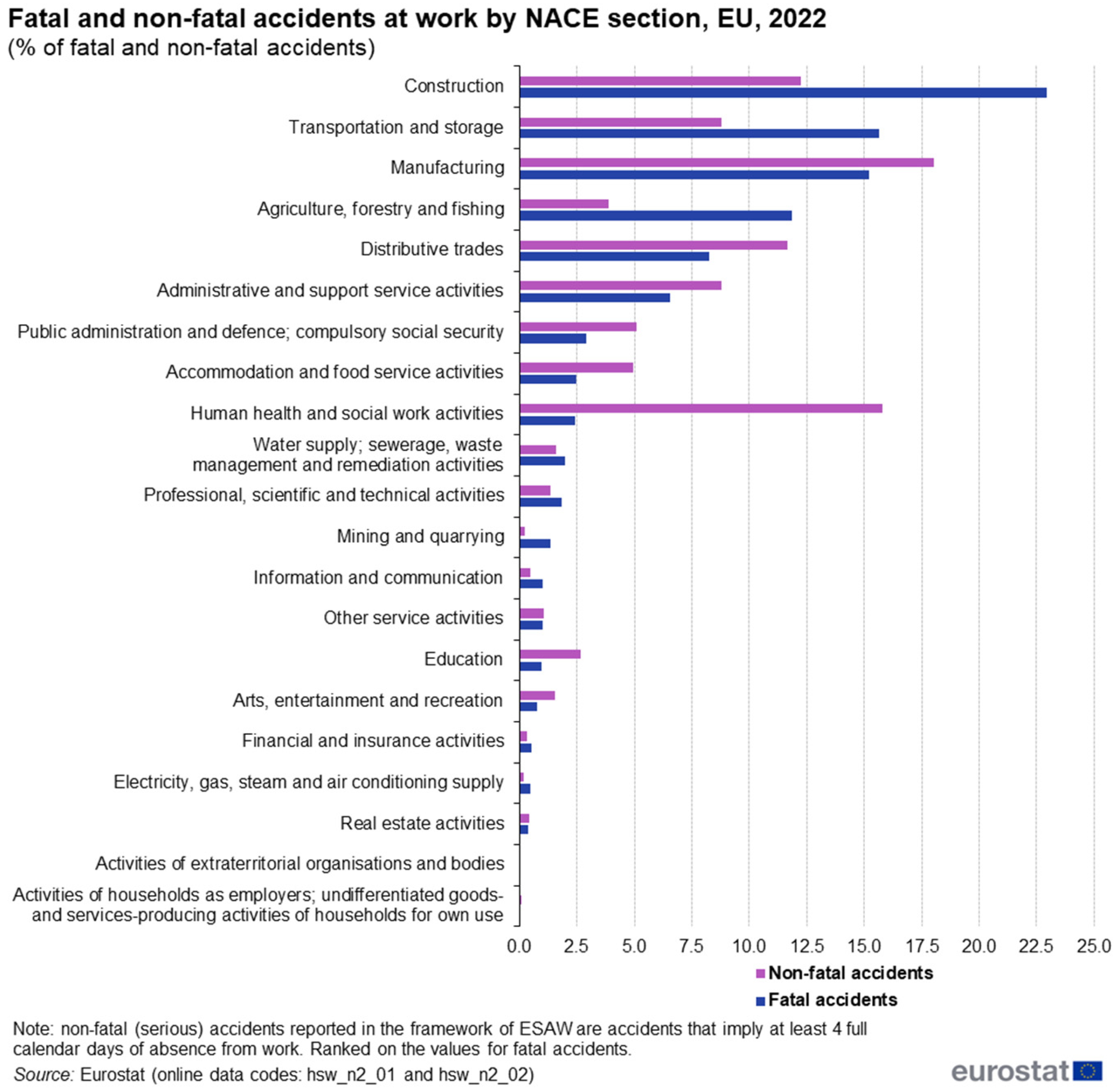

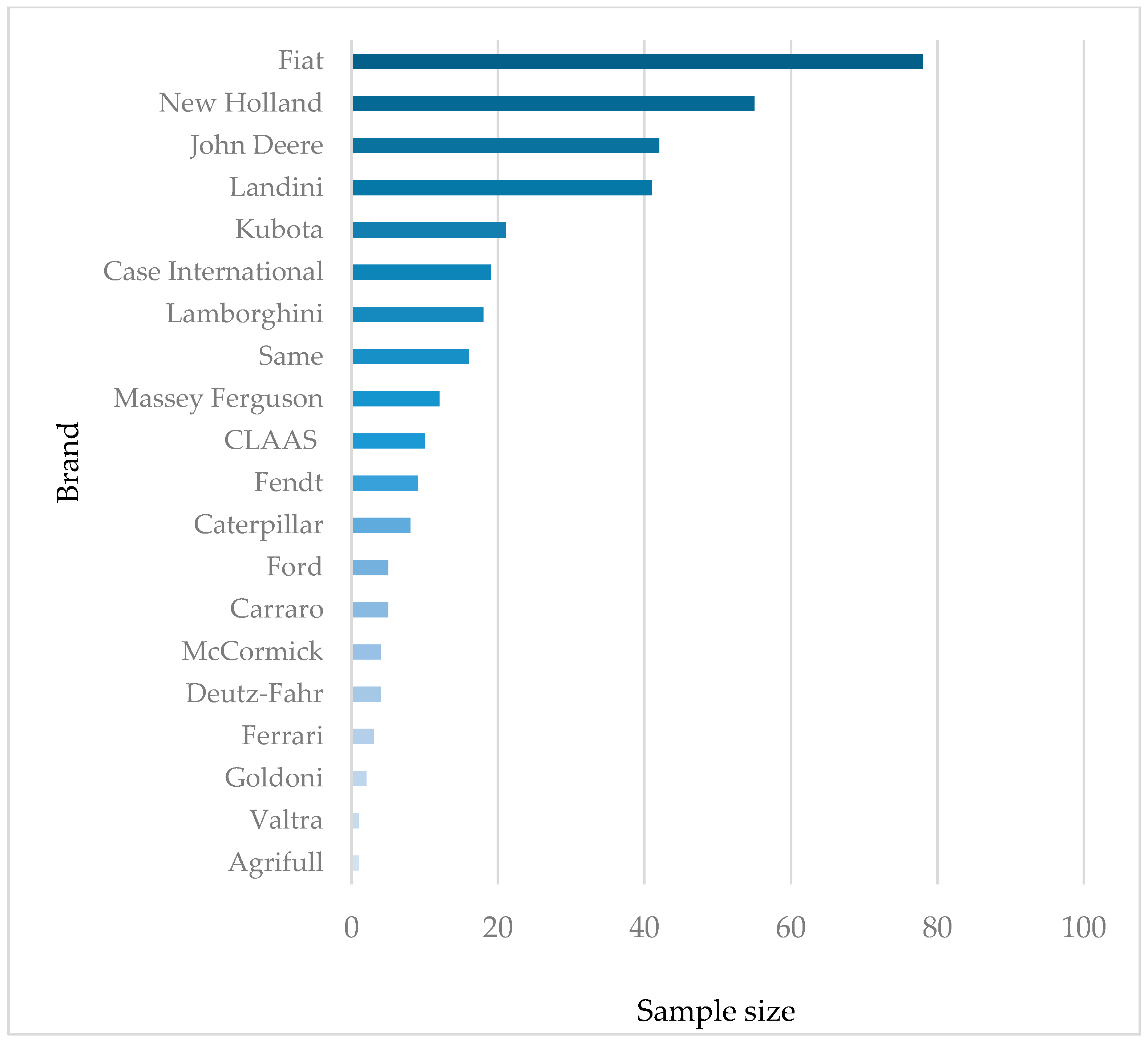
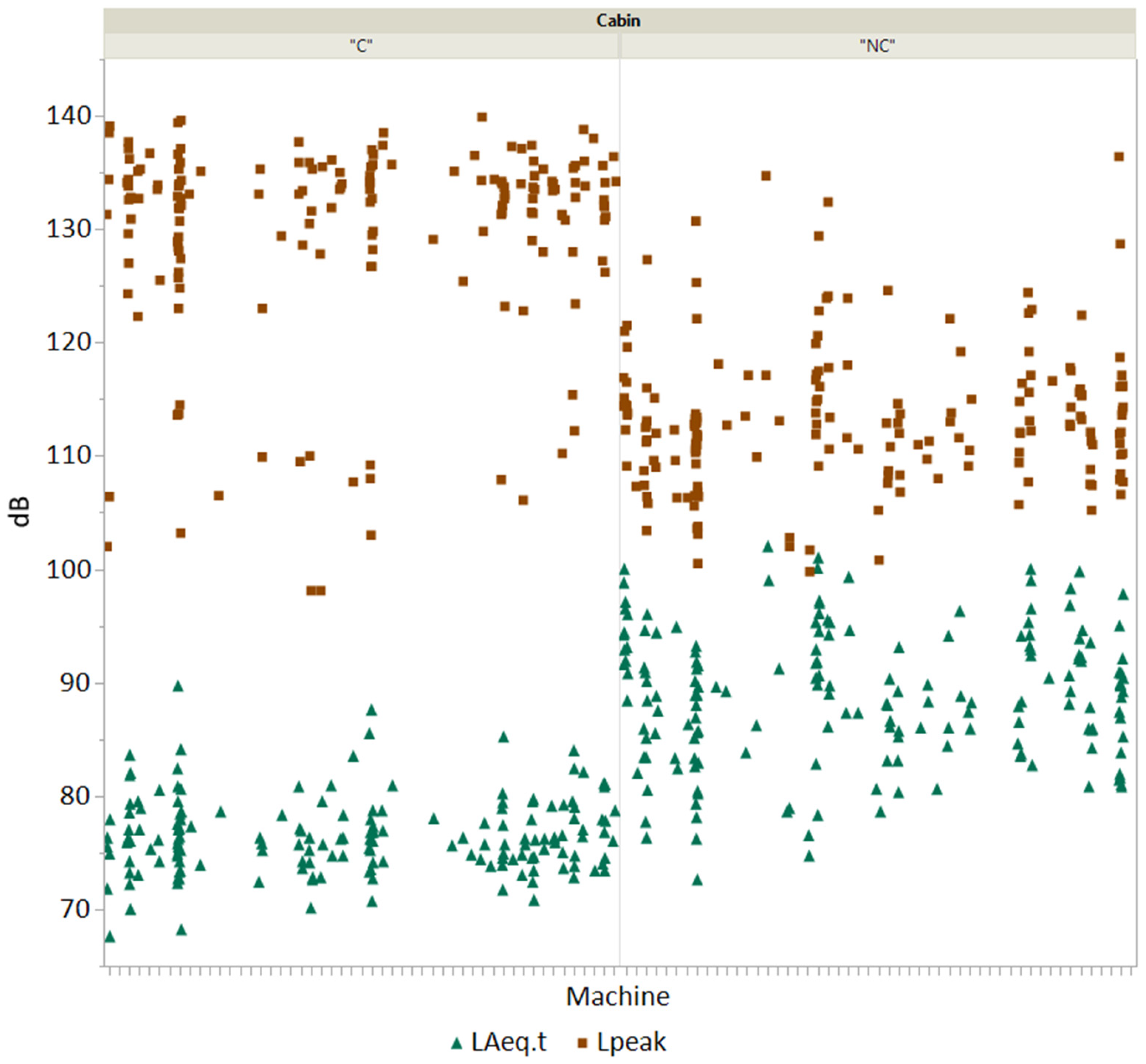


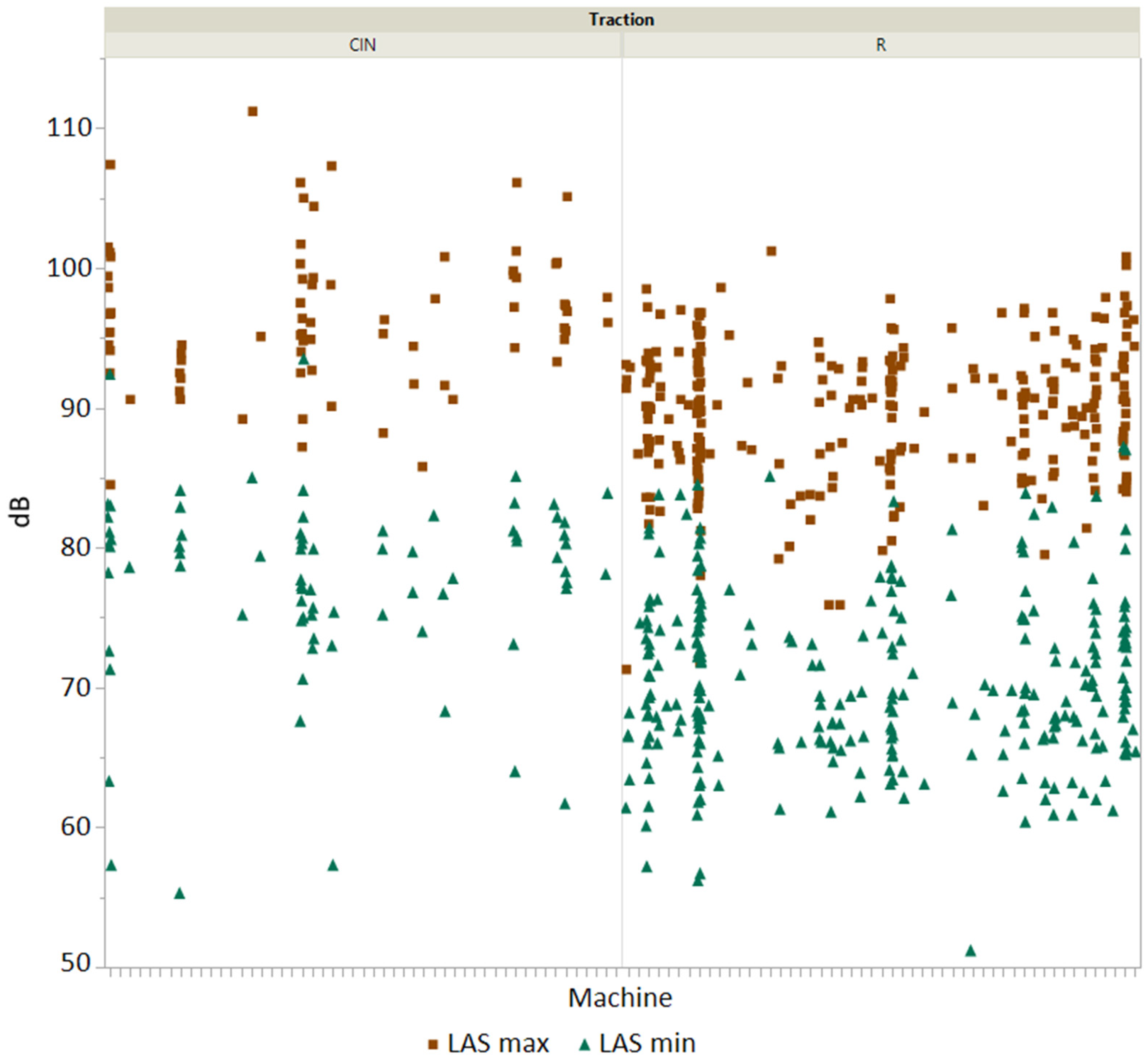
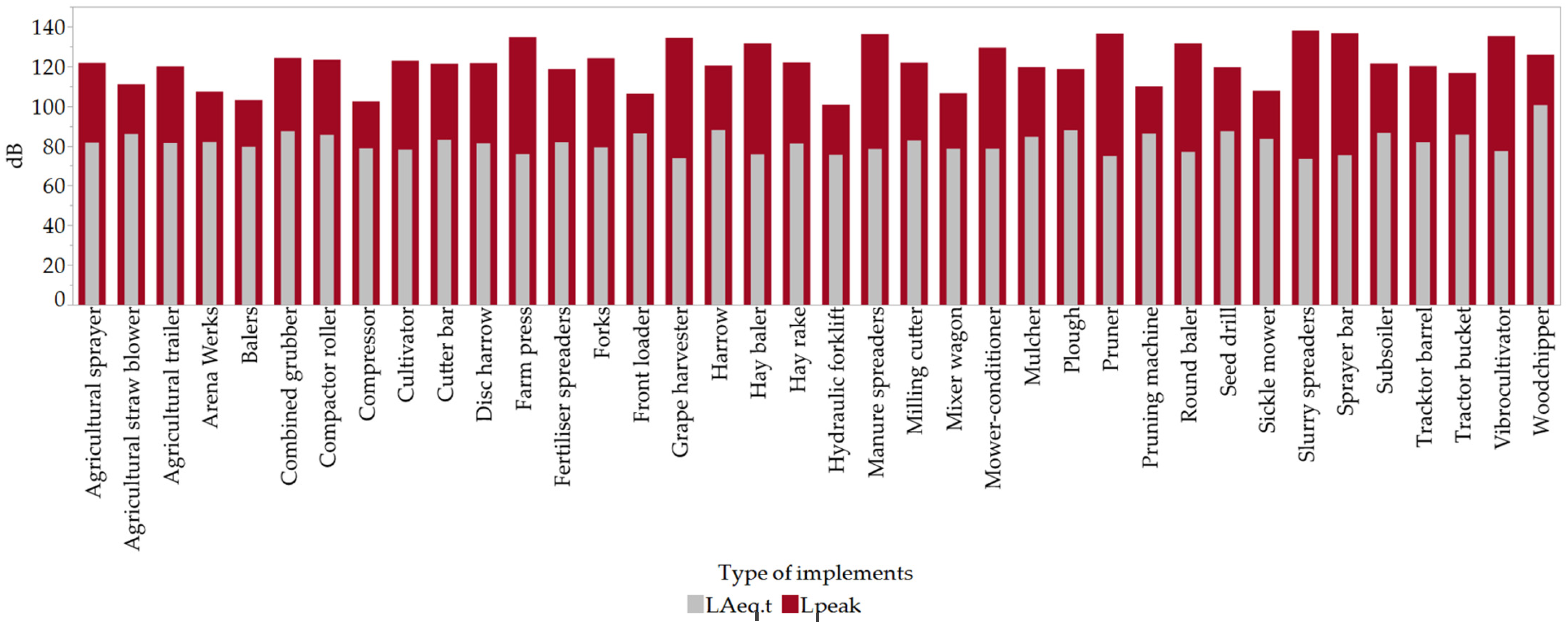
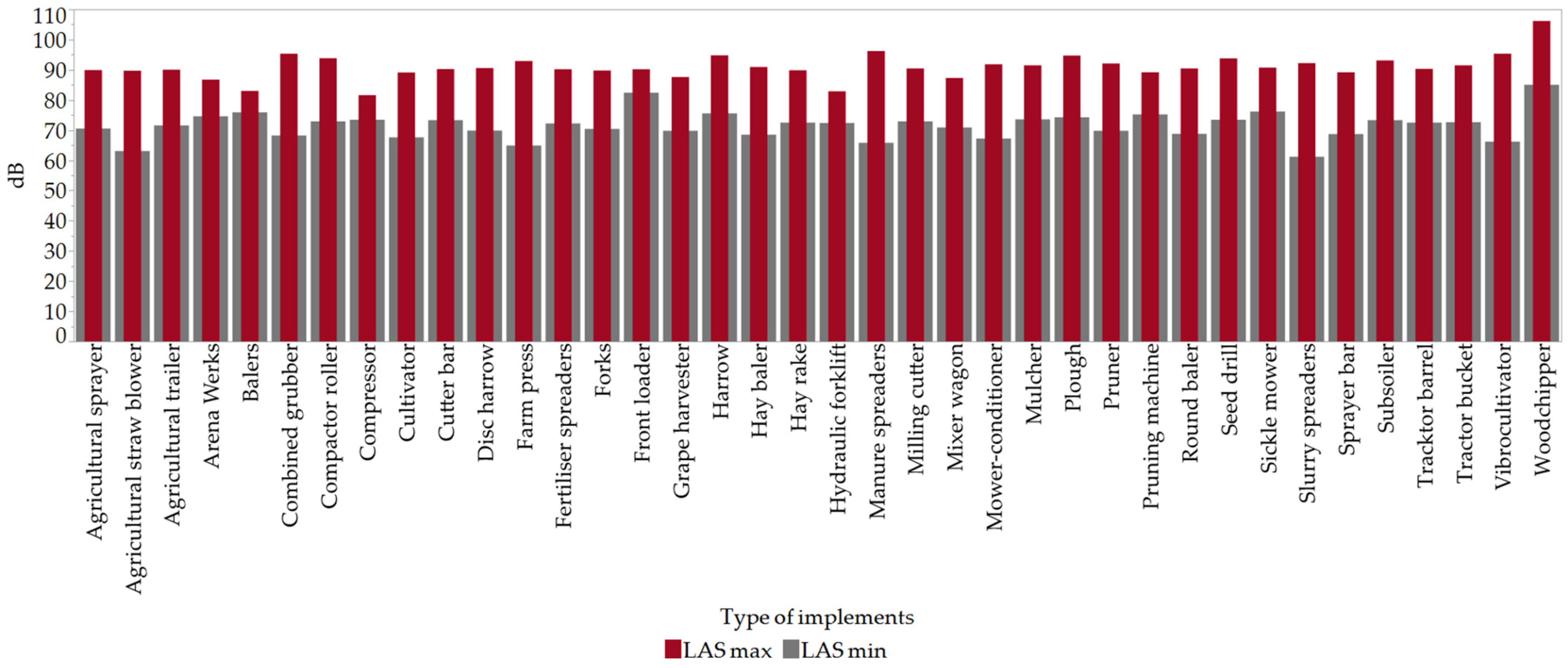
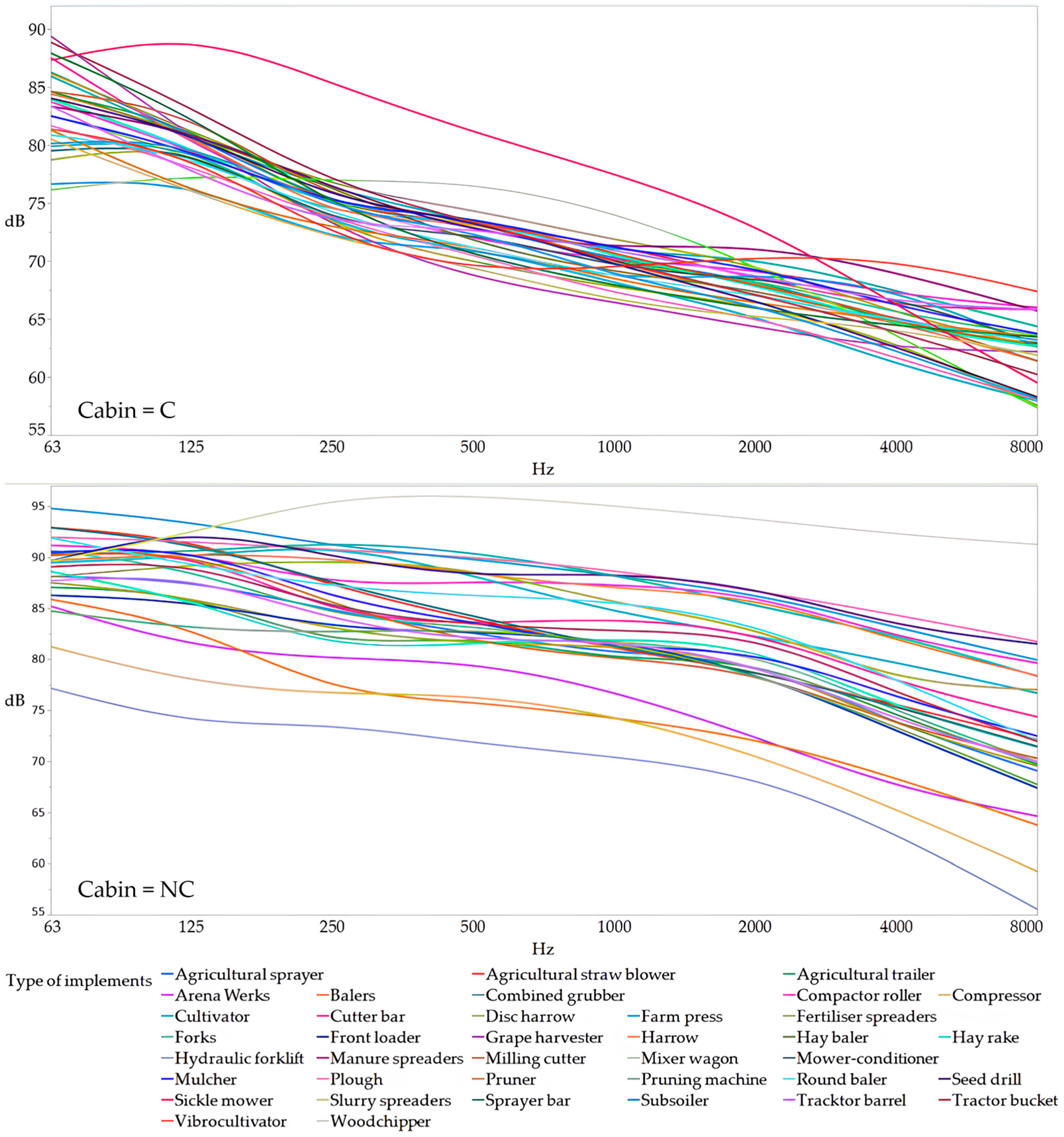
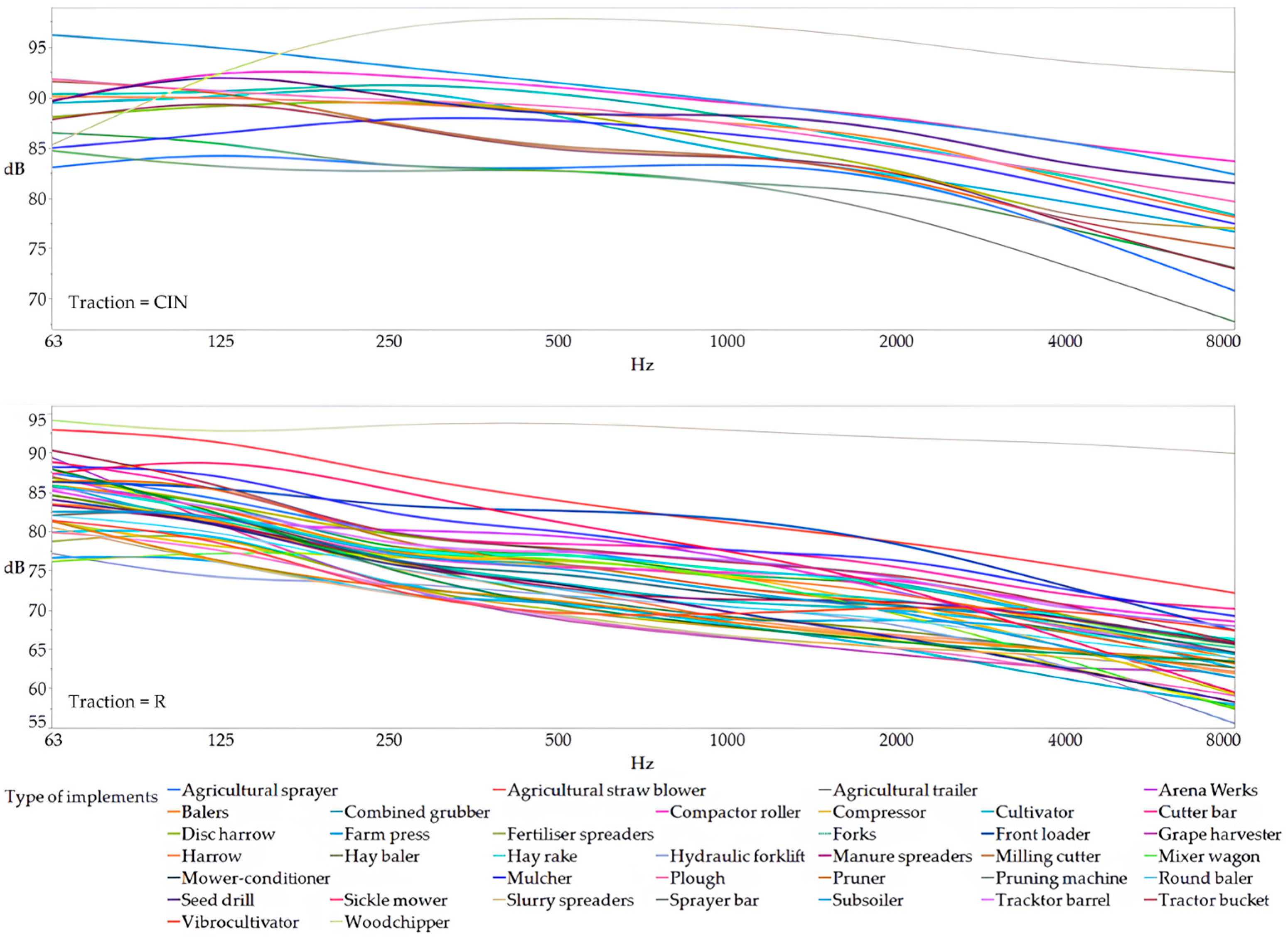
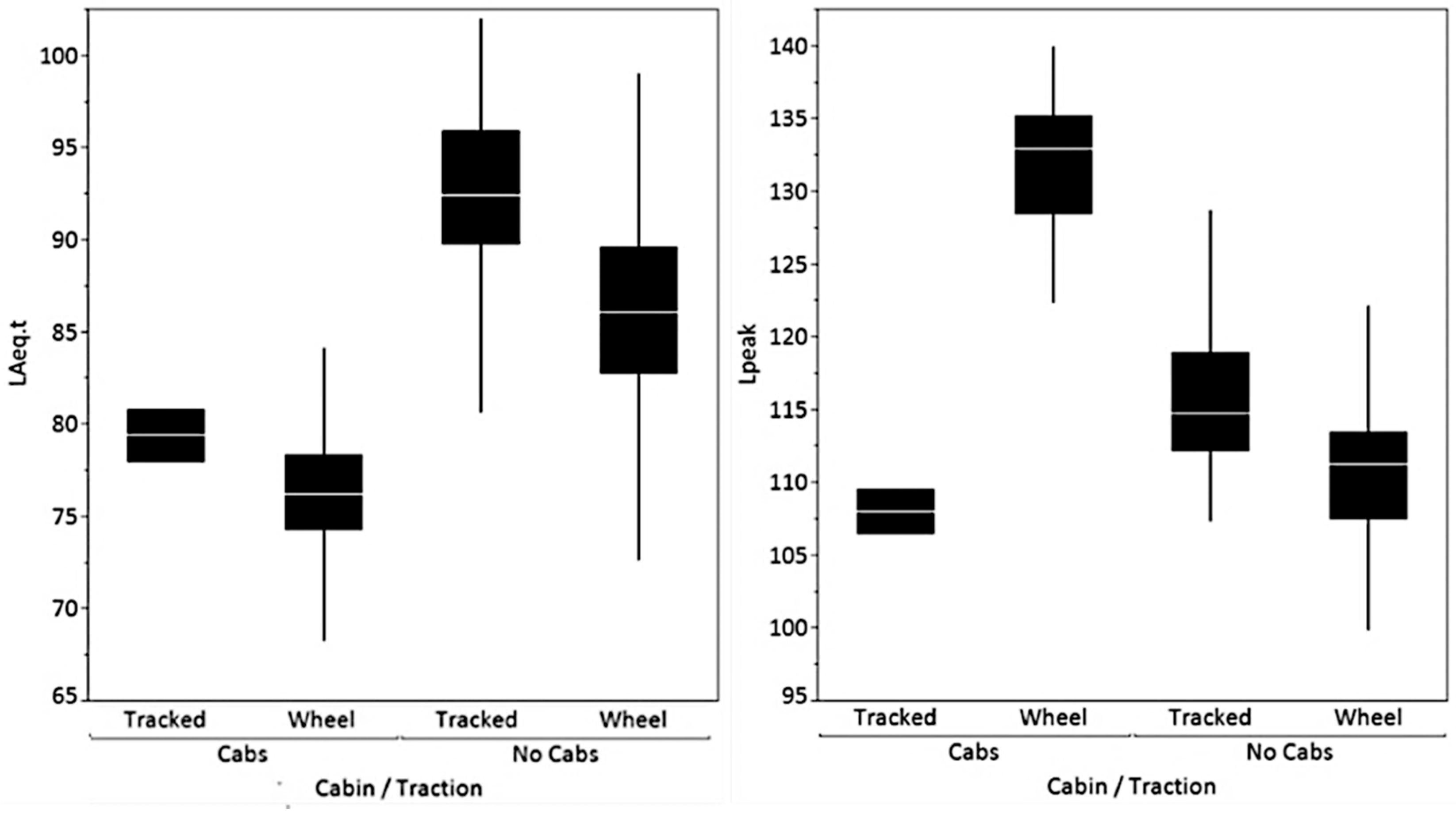
| Manufacturer | Model |
|---|---|
| Agrifull | Toselli |
| Carraro | SRX 8400, Tigrone 7700 |
| Case International | 105U Farmall, CVX120, MX 135, Optum CVX 300, 1056 |
| Caterpillar | Challenger MT, D5, D5B SA |
| CLAAS | Ares 356, Nectis 267 F |
| Deutz-Fahr | 105 |
| Fendt | 820 |
| Ferrari | Thor AR EP 85, Thor AR EP 86, Thor AR EP 87 |
| Fiat | 110-90, 666 DT, 70-66 DT, 80-66 DT, 80-90, F115, 100-55, 100C, 120C, 1355C, 605C, 70-65, 80-65, 880 DT, AD 7, FA 150, 100 C, 605 C, 70-75, 1580, 1000 DT Super, 466 DT, 480 DT, 600 DT, 65-66 DT, 666 DT, 670 DT, 72-86, 780 DT H, 880 DT, 980 DT, 55-66 DT |
| Ford | 7810, 4830 |
| Goldoni | 233 |
| John Deere | 3350, 5100, 5400, 5820, 6210, 6310, 6420, 6520, 7700, 50105 GF, 8320 RT, 3140, 1026R, 2030A |
| Kubota | M135GX, M7060, M9540, V3800-CR-TI-EU10 |
| Lamborghini | 150, 1489, 2081, 774-80, Crono 554-55, 150 |
| Landini | 9880, REX 100 GT, Rex 85 GE, 6830, Trekker 100, Trekker 105, Trekker 90 F, Trekker 95, 8550, 10000 S, Mistral 50, Rex 90 GE, Rex 100 GE |
| Massey Ferguson | 6480, 500 SA |
| McCormick | CX 95 Extract |
| New Holland | 6070, G240, T6, T6.140, T7, T7.210, TL90, TN75DA, TN75F, T4050F, TN65F, TN85FA, TN90F, TN95FA, 88-85, TK 4050M, TK 80 MA |
| Same | Frutteto 100, Explorer 70C, Krypton 105, Dorado75, Explorer 70, Explorer 70, Frutteto 90, Tiger Six 105 |
| Valtra | T120 |
| Type of Implements | ||
|---|---|---|
| Plow | Harrow | Subsoiler |
| Sprayer | Mower-conditioner | Round baler |
| Cutter bar | Baler wrapper | Compactor roller |
| Sprayer bar | Milling cutter | Seed drill |
| Front loader | Tractor bucket | Broadcast fertilizer spreaders |
| Trailer | Pruner | Manure spreaders |
| Woodchipper | Hay baler | Slurry spreaders |
| Compressor | Grape harvester | Mulcher |
| Hydraulic forklift | Rakes | |
Disclaimer/Publisher’s Note: The statements, opinions and data contained in all publications are solely those of the individual author(s) and contributor(s) and not of MDPI and/or the editor(s). MDPI and/or the editor(s) disclaim responsibility for any injury to people or property resulting from any ideas, methods, instructions or products referred to in the content. |
© 2025 by the authors. Licensee MDPI, Basel, Switzerland. This article is an open access article distributed under the terms and conditions of the Creative Commons Attribution (CC BY) license (https://creativecommons.org/licenses/by/4.0/).
Share and Cite
Di Stefano, V.; Cecchini, M.; Riccioni, S.; Di Domenico, G.; Bianchini, L. Exposure to Noise from Agricultural Machinery: Risk Assessment of Agricultural Workers in Italy. AgriEngineering 2025, 7, 87. https://doi.org/10.3390/agriengineering7030087
Di Stefano V, Cecchini M, Riccioni S, Di Domenico G, Bianchini L. Exposure to Noise from Agricultural Machinery: Risk Assessment of Agricultural Workers in Italy. AgriEngineering. 2025; 7(3):87. https://doi.org/10.3390/agriengineering7030087
Chicago/Turabian StyleDi Stefano, Valerio, Massimo Cecchini, Simone Riccioni, Giorgia Di Domenico, and Leonardo Bianchini. 2025. "Exposure to Noise from Agricultural Machinery: Risk Assessment of Agricultural Workers in Italy" AgriEngineering 7, no. 3: 87. https://doi.org/10.3390/agriengineering7030087
APA StyleDi Stefano, V., Cecchini, M., Riccioni, S., Di Domenico, G., & Bianchini, L. (2025). Exposure to Noise from Agricultural Machinery: Risk Assessment of Agricultural Workers in Italy. AgriEngineering, 7(3), 87. https://doi.org/10.3390/agriengineering7030087









